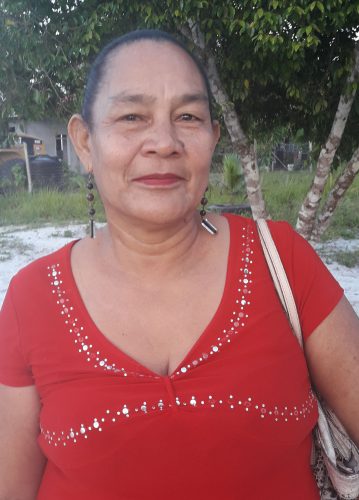Waiakabra is a village on the Linden-Soesdyke Highway. Not many people are familiar with it as it is often mistaken to be part of Kuru Kururu, which is situated opposite; others think it is called Ideal owing to the name of the road.
The village has been here for decades and is home to some 300 families. No one is sure how the village got its name, but villagers say it was there before the factory— the once famous Guyana Refrigerators Limited which manufactured refrigerators and freezers—that has long since closed its doors, but had once been a source of income for many.
Waiakabra began as an Amerindian village, it was said, but today the population is mixed.
Ideal Road runs all the way to Madewini and serves as a route to the highway for persons living there. Mark Hendricks, originally from Santa Mission, now lives in Madewini and was enjoying the view of the village and the huge sandpits behind it, said he has children attending Kuru Kururu Primary School had left Madewini to attend one of his children’s graduation.
Shirley Harrison lives in Waiakabra and takes care of a place for another resident. She had her home where she grew up with a grandmother who raised her, but it was sold for the purpose of operating a sandpit. She hails from Aratak in the Cuyuni River, where she spent the first eight years of her life before she and her brother moved to live with her grandmother, who at the time lived in another village along the highway called Clovis. When she was ten, they moved to Waiakabra.
Her grandmother, she said, worked hard to take of her and her brother. She worked on many pineapple farms that were privately owned, keeping them clean by weeding the grass. Harrison attended St Mary’s Primary School in Soesdyke but never did finish as her grandmother found it difficult to send her to school. When she attained the age of 19, she said, her grandmother urged her to get married, so that she would no longer have the responsibility of taking care of her. She got married and later had seven children. Harrison said she has never been employed and today at 64 years old, her two sons help to maintain her.
Then her grandson, Anthony, returned home. He had been off playing with friends. He has begun his August vacation early and is spending it with his grandmother. He is an orphan, she explained. He lost his mother to hypertension when he was 10 months old and some years later, his father, Harrison’s son, was murdered.
Speaking about the village, Harrison said it was quiet and safe.
It has had potable water for less than a year now. The village is still without electricity though promises have been made year after year, the last time being this year. Residents are now impatient. The main road is all sand and riddled with potholes. Harrison is pleading for the road to be done and for streetlights. A few buses running the road is another service she hopes for. For a long time, they have been paying taxis between $500 and $1,000 to get from the Soesdyke junction to their homes.
Roxanne DeFreitas was on her way home when we met. She was coming from a wake; a relative of her husband had died. She lives almost at the end of the village.
DeFreitas was born in Santa Mission, grew up there, got married there and had some of her 12 children there. However, she was forced to move as there was no secondary school for her eldest daughter to attend. Her daughter, she said, had her heart set on becoming a nurse and she wanted to see her achieve this; she proudly said her daughter has been a nurse for the last 33 years. It was through this daughter that she some years later welcomed another daughter. Her daughter had told her of a baby girl living in the hospital who needed a home. The baby girl, who she later adopted, was then six days old. She is 20 years old today and still lives with DeFreitas along with DeFreitas’s youngest, a 17-year-old son.
DeFreitas works as a domestic help as well as plants her own little farm; her husband works on another farm. For 24 of the 25 years she has lived in Waiakabra she and the other villagers struggled without any water. They all depended on the creek at the bottom of the village.
The woman noted that every day she goes to work she spends close to $1,000 to get to and from work. She takes public transportation to her place of work in Friendship and returns with a taxi.
Although there are a few shops in the village that people depend on and where she gets groceries sometimes, but she often chooses to shop in Soesdyke on her way home.
DeFreitas hopes for a village farm and market square where villagers can buy farm produce even if it is once a month.
Taking directions, we head in search of Jo O’Selmo. A huge grasshopper hopped across our path. We asked a man to direct us and he said: “I am Jo O’Selmo.”
His name is Lloyd O’Selmo; it was also his father’s name and to differentiate he was called ‘Junior’ then ‘Jo’ for short. O’Selmo hails from Matthews Ridge, North West District and left 12 years ago with his family in search of a better life and a proper education for his children. Today O’Selmo is one of the representatives of Waiakabra.
He learnt of the village, he said, because he had relatives living there already; they later migrated to the US. He still has a number of his relatives living in the village. Although transportation needs to be improved, O’Selmo said life in Waiakabra was way better than his life was in Matthews Ridge. He is self-employed and does construction. Though the village has produced doctors, nurses and teachers, unemployment is an issue. Other persons in the village do construction as well, or work in the gold industry.
Before they benefited from the potable water service, O’Selmo said he depended on the rain. One man who had a truck and black tanks to store his water in, would full water at the creek and drive through the village selling the creek water. In the dry season when there was no rain and the creek ran dry, O’Selmo had no other choice but to buy bottled water from the truck for bathing, cooking, drinking and washing. They use solar panels and generators for light.
Another thing O’Selmo wishes for is a nursery school for the children. There are more than 300 children in the village and a number of them attend the Kuru Kururu Nursery School.

















